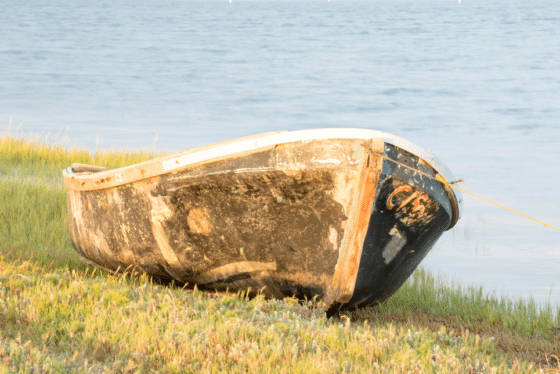
Classic old boats have a lot of beauty under those dull, oxidized finishes, and with some effort, you can bring some shine back to the classic lines of that tired-looking but classic fiberglass boat. It’s hard work, but the results can be spectacular. Here are some of our top boat restoration tips.
Oxidation is Your Enemy
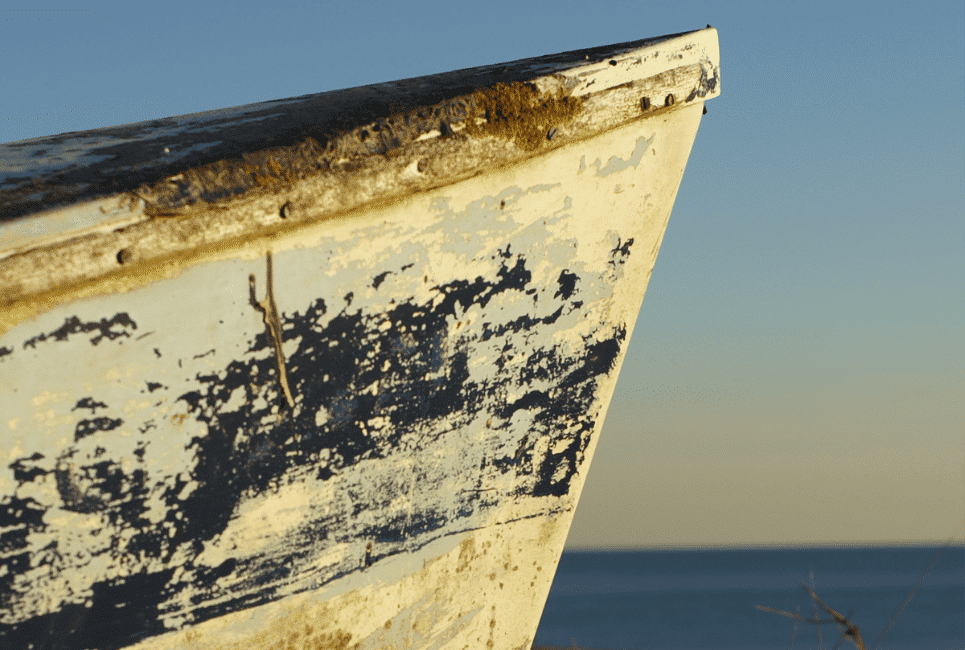
Gelcoat is the layer of resin on the outside of your boat that holds the color and protects the fiberglass underneath from the elements. It has no stiffening strength, but it takes a beautiful shine when polished. But it’s not impervious, and sunlight and salt water can wear it and age it.
That chalky white stuff clouding your older boat’s finish is oxidation, the long-term result of gelcoat aging in the sun without regular washing and waxing. A boat gets its beauty and shines from the gelcoat layer over the structural fiberglass, but age, neglect, and exposure to the elements lead to discoloration and loss of shine. To bring back a boat’s glossy finish, you polish away the oxidized layer and put a new finish on the gelcoat.
You might also be interested in: Pontoon Boat Covers: Which is Best for You?
Fiberglass Boat Restoration Tips
There are several steps to restore cloudy, oxidized fiberglass to bring the color back to your boat. You need to clean the hull, polish out the faded surface, then protect it all once you’ve brought back the shine. How you approach each step depends on just how much oxidation you have on the gelcoat.
Always wear protective clothing, gloves, and eyewear throughout the entire process. Almost all the detergents, solvents, and compounds used can irritate your skin or hurt your eyes.
Clean, de-grease, and de-wax the Hull
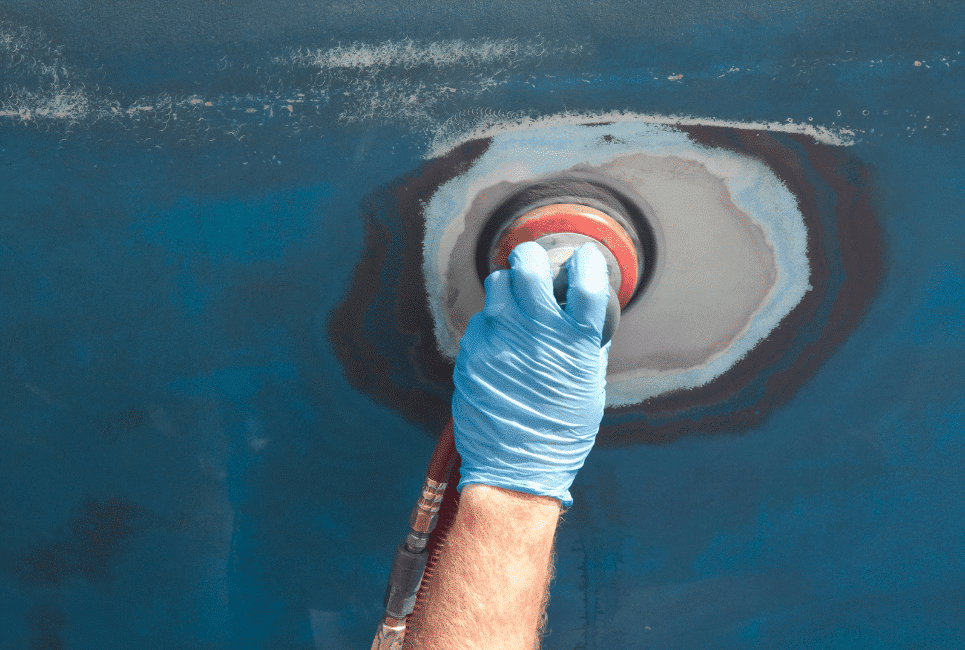
From stem to stern, clean the hull with quality boat soap, and remove all surface dirt or debris. Scrub well, and leave nothing on the surface. You’re going to be rubbing and polishing the hull, and you don’t want to grind dirt and grit into the surface.
To ensure there’s no grease or wax on the hull after you’ve scrubbed the hull with detergent, clean the hull again with MEK or acetone and clean the rags. Fold and turn your rags to keep working with clean spots.
Remove stains
Clean as many surface stains off the boat. Tougher water and rust stains may not come off with a scrub brush and soap, so you may need a special cleaner. Take care to follow the instructions carefully and wear protective gear as directed, most of these special cleaners use harsh chemicals or acids. Rinse all heavy-duty cleaners off with plenty of fresh water when you’re finished.
If you can’t get the worst stains out, buffing may still get them off, but it’s best to clean them first.
Buff with Rubbing Compound to Remove Oxidized Gelcoat
Rubbing or “cutting” compound is a liquid with abrasives suspended in it that can remove surface layers of oxidized gelcoat. To buff your boat, start with a small section of the hull and buff by hand or with a polisher. Work in small sections of about two feet square, and don’t let the compound dry on the hull.
For smaller boats, you can buff by hand, but for larger and heavily oxidized boats a high-speed buffer with a soft buffing pad is recommended. As you buff each section of the boat, follow the instructions on the compounding liquid about application and removal.
Always keep an electric buffer moving, and don’t press too hard in any one spot or you may damage the gelcoat. The goal is to remove as little material as possible while removing the oxidized layer.
If the rubbing compound isn’t taking the oxidation off, you may need to wet sand. Wet sanding with 1200-grit paper is more aggressive than rubbing compound but may be necessary. You can also try multiple passes with the polisher and rubbing compound.
Polish and Shine
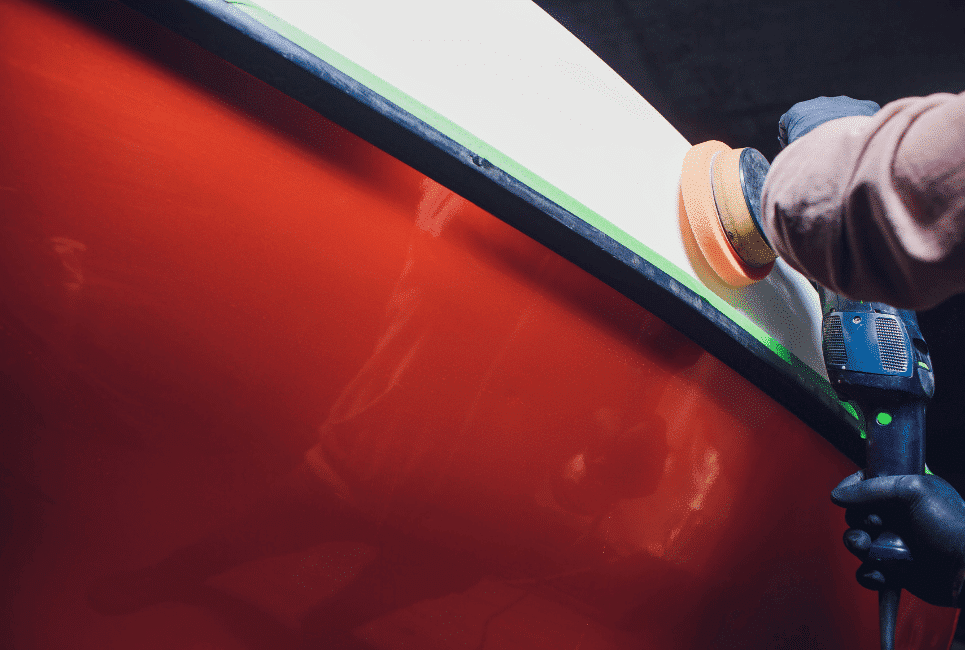
Boat polish differs from rubbing compounds in the grit of the abrasives. It’s much finer and will remove any fine surface scratches from wet sanding or compound rubbing to leave a bright, shiny finish.
The process is like buffing with the compound – work in small patches and don’t let the compound dry, working your way around to polish the entire hulk.
Apply Wax to Protect the Hull
The last step to preserve your hard work and keep the boat shiny longer is a good application of wax. Wax is best applied on cooler, overcast days, to slow drying and give you more time to buff. Apply wax to a small section of the boat, and buff it off as per the instructions.
NOTE: You can often find one-step “polish and wax” products. If you’re already compounded the hull and are ready to polish, this can be a time saver, cutting out one step.
The Right Tools for Restoring Your Fiberglass Boat
You’ll need a fair amount of tools, rags, and chemicals to restore your boat, so plan and make sure you’ve got what you need before you start.
To do the job right, you’ll need to include:
- Rotary buffer or polisher
- Buffing pads
- Lots of clean rags
- Boat soap or detergent
- Boat brush.
- Stain removers (as needed for rust, water, and other stains)
- Rubbing and finishing compound
- Boat wax
- Protective gear – gloves, coveralls, eye protection, as needed.
- MEK, acetone, or another degreaser.
- Hose, source of water, bucket, and sponge.
Choosing Buffers and Polishers
Buffers come in several types – random orbital, rotary, and high speed. And cordless and corded.
Random orbital buffers and polishers use an offset rotor to move the buffing pad in random back-and-forth motions, versus a straight, rotary motion. Random orbital polishers are good for wax jobs or light polishing. But they don’t spin quickly; only a high-speed rotary polisher will have enough speed to build the heat you need to get the oxidation off your boat. If you have a serious restoration to do, you will need a high-speed rotary polisher.
Whether or not to get a corded polisher is a matter of budget and preference. Corded units are cheaper and never run out of power, but cordless tools let you work without a plug. Neither one will survive a drop in the water well, so secure them with a lanyard.
No matter which you use, never stop the buffer in one place on the boat, as you can mark the hull and damage the gelcoat.
If you also wanna prepare your boat for winter, take a look at this post: A Guide to Winterizing Your Pontoon Boat
Picking Compounds and Waxes for Polishing
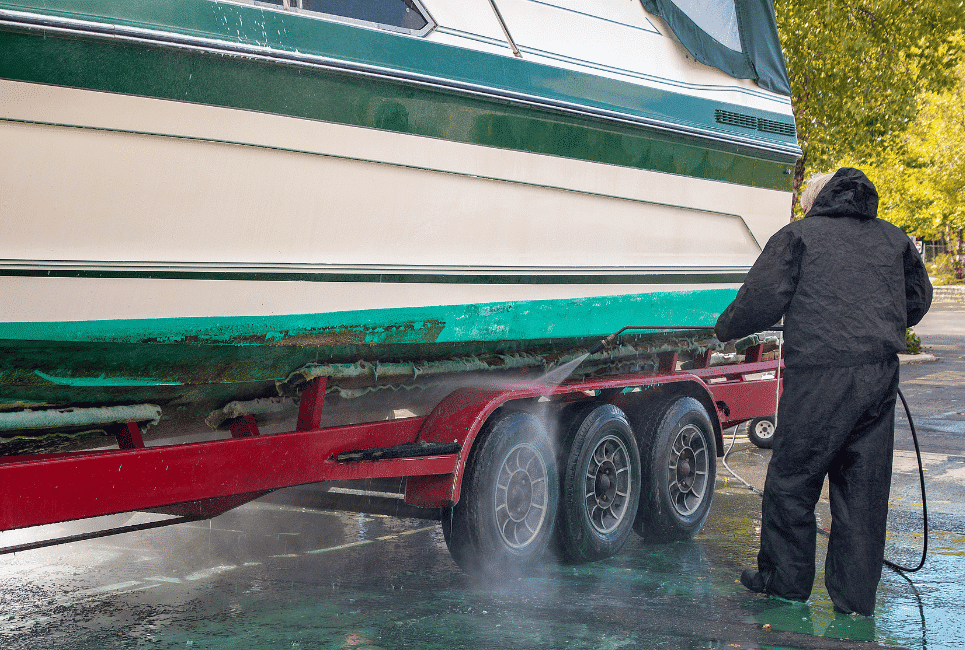
There are dozens of rubbing, polishing, and “cutting” compounds on the market. Unfortunately, they’re rarely labeled by specific characteristics like grittiness or what sort of liquid it is. Rather, they’re labeled with words like “quick,” “fast,” “heavy,” and so on.
For strongly oxidized hulls, you want the coarsest cutting compound you can get that won’t damage the gelcoat or leave visible scratches you’ll have to buff out. If you can’t tell the coarseness from the labeling, check the manufacturer’s website for more detail.
Almost all of them are hazardous and can irritate the eyes and skin.
Waxes range from pure wax pastes to easy on/off liquids and combined polish/wax products. Most of the easy application products work well, and you may save some work with a polish/wax combination.
Read also:





